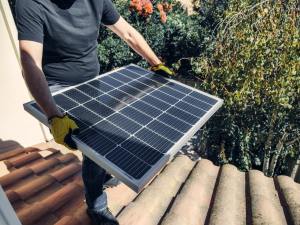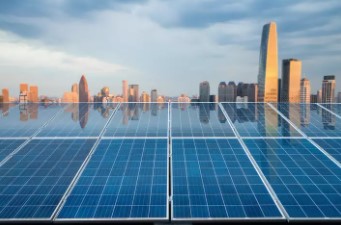
Illinois’ ambitious distributed solar incentive program has reopened and is quickly clearing an application backlog after stalling for months in 2022 and early 2023 while transitioning to a new program administrator.
As of June 1, incentives are again available for small and large distributed solar arrays, community solar, and solar on public schools. The state is also implementing new workforce equity requirements for contractors on projects that receive the incentives.
And changes to community solar incentives mean that projects will be evaluated and prioritized based on criteria that include readiness for development and impact on agriculture production.
Brian Granahan, acting director of the Illinois Power Agency, which oversees the solar incentive program Illinois Shines, said he’s hopeful the program is launching into a new and successful phase, as hiccups have been worked out following the passage of the 2021 Climate and Equitable Jobs Act that expanded and jump-started the state’s solar push.
“I think this is a great story we’ll be able to look back on, and realize we’ve made a real pivot in terms of the overall energy mix,” Granahan said.
Get Connected
Every morning, thousands of energy professionals turn to our newsletters for the day’s most important news. Sign up for free to get the latest delivered straight to your inbox.
A new contractor, an Oakland-based firm called Energy Solutions, last year took over from InClime in running the solar program. The application portal was shut down for 60 days in the summer of 2022 while data was migrated from the old system to a new one. A fast-tracked round of incentives — the right to sell lucrative renewable energy credits, known as RECs — was launched in fall 2022.
Since then, Energy Solutions and the Illinois Power Agency have been working to reduce a backlog that has caused months-long delays in some customers getting incentive payments. The agency has been providing online updates on the application queue three times a week.
Some solar developers worried the backlog would dissuade residential customers from participating, as the delays were sowing uncertainty, especially given a past “solar cliff” fiasco wherein funding for incentives created by a 2017 state law ran out.
The delays in processing applications over the past year mean some customers have had to pay interest or even principal on loans they had taken out in anticipation of recouping their costs through REC payments.
“Consumers don’t understand that this is not a funding problem; it’s a processing problem,” said Michelle Knox, founder of Illinois-based WindSolarUSA. “They will be like, ‘Oh, here we go again. The state’s not making payments — you can’t rely on them for anything.’ But that’s not the case. We want to dispel that myth.”
Energy Solutions senior director Patrice Flynn said the firm is now processing about 1,500 applications per week while receiving about 600, “so we are quickly closing the gap and are on track to resume normal turnaround times of two weeks or less by this summer.”
Flynn said the process has been sped up in part by more than tripling staff and automating some verification steps. Flynn said Energy Solutions has enabled invoicing for $200 million in RECs since the transition.
“It has been a big effort. We’ve made great progress over the last quarter in close coordination with [the Illinois Power Agency], and I’m excited about the momentum that is building.”
The delay was exacerbated by a rigorous review process for projects receiving RECs, largely to protect customers and ratepayers from unscrupulous actors. This was especially a concern given that Illinois in the past has struggled with alternative retail electric suppliers whose agents went door to door peddling predatory renewable energy plans. And since ratepayers are ultimately funding the incentives, the state needs to make sure claims are legitimate.
Granahan noted that there has never been a delay in when solar systems can actually be energized, on the state’s part, though utilities may have delays in interconnecting projects to the grid.
“Systems that are up and running are benefiting the customer already,” Granahan said. Even if one isn’t getting incentive payments, “you’re still benefiting from net metering, you’re still offsetting [energy] usage.”
Roger Lee of Springfield is among those frustrated by an unanticipated delay in receiving REC payments for his solar system, though he still has faith in the program’s potential.
Knox and her colleagues helped him through the process to apply for Illinois Shines and install a 10-kilowatt system on his barn a year ago. But Lee still has not been able to sell RECs to receive the funds promised under Illinois Shines. He had expected those payments within six to nine months.
“Had we received these funds in the time frame originally stated, they could have been invested in other projects,” he said. “As a former banker, I am very aware of return on investment and the net present value or time value of money.”
Still, Lee has saved about $130 a month on his energy bills, he said.
“Additionally, nearly 21,000 pounds of CO2 have not been released into the environment, the equivalent of 158 trees planted,” Lee said, by email. “We are very pleased with our decision to have solar installed.”
Community solar has been among the most popular parts of Illinois’ solar program. In previous rounds of incentives under the 2017 Future Energy Jobs Act, community solar applications poured in and chaos ensued.
There were applications for projects representing more than eight times the capacity available in the program, Granahan said, so projects were chosen through a lottery and many applicants failed to receive incentives. The program was dominated by developers looking to build the maximum 2-megawatt projects with small numbers of large entities as subscribers.
The new community solar evaluation process ensures the most viable projects are chosen, using “qualitative criteria,” Granahan said, and avoiding “turning this into one of those first-come first-served Ticketmaster situations” where applicants scramble to be first in line.
The 2021 Climate and Equitable Jobs Act also created a new category for community-driven solar, meant to support the type of projects that many envision when they hear “community solar”: arrays spearheaded by a church or nonprofit organization that offer subscriptions to individual customers who want solar energy but can’t get it on their own property.
Incentive applications for such traditional community solar projects due in November were evaluated and ranked based on various criteria. After a chance for appeals of scores, incentives were awarded in late May. The June 1 new program year means traditional community solar projects can now apply for a new round of funding.
Illinois Shines aims to spread solar across the state in proportion to where the electricity load is located. That means about 70% of incentives are allocated for northern Illinois in utility ComEd’s territory, and the rest for downstate Illinois served by Ameren. Applications for downstate Illinois have exceeded capacity, Granahan noted, while applications in ComEd territory have been fewer than the incentives available.
Granahan said this outcome was somewhat surprising for policymakers, who expected high participation from well-to-do residents in Chicago suburbs.
“We’re unpacking why there’s more interest in the bottom two-thirds of the state,” said Granahan. “There’s not any one theory, but electricity prices have been higher in Ameren service territory.” That means in Ameren territory, “the payback period will be shorter than in northern Illinois.”
Solar experts and advocates have said they are encouraged by the booming interest in solar in downstate Illinois, and the disproportionate applications could be related to how farmsteads and rural neighborhoods are often more suitable for solar than urban communities.
Granahan noted that REC prices are adjusted with each round of incentives. In downstate Illinois, they will decline in part because of the robust demand; in Northern Illinois, they will increase slightly “to increase participation.”
The Climate and Equitable Jobs Act created a new incentive category for public schools, but it has seen few applicants — none yet in northern Illinois. Granahan said that solar developers seem to prefer applying for school projects through another program for large distributed generation, for procedural reasons. The state legislature this spring passed legislation that changes the criteria for public school applications in hopes of sparking more applications. Among other things, it would allow for solar arrays on any land owned or leased by school districts, while currently the array must be at the school site itself.
A separate program, Illinois Solar for All, aims to make solar energy and jobs available especially to communities that have been most impacted by or left out of the fossil fuel economy. Lower-income neighborhoods in Chicago and the suburbs qualify for this program, and the Illinois Solar for All program administrator, the nonprofit organization Elevate, is working with community groups to spur participation.
The Climate and Equitable Jobs Act’s provisions meant to increase the diversity of the solar workforce have also apparently been successful. Commercial and community solar projects receiving incentives must show workforces have 10% of their staff meeting equity criteria by 2024 and 30% by 2030.
Applications for such certification flooded in, and the state fast-tracked them. Granahan said the state is prioritizing the equity focus, building out its Diversity-Equity-Inclusion team and doing outreach to potential solar employees and trainees.
In years past, solar developers have struggled to find a diverse pool of employees, even as graduates of solar job training programs struggled to find jobs. The state is trying to relieve this mismatch with a portal wherein workers can register if they are “equity eligible,” including if they are graduates of the foster care system, formerly incarcerated, or live in environmental justice communities or communities disproportionately impacted by the war on drugs, as defined by the state’s cannabis legislation.
“People can look at that and say, ‘Do I qualify? If so, I’m really valued in this clean energy economy.’”



